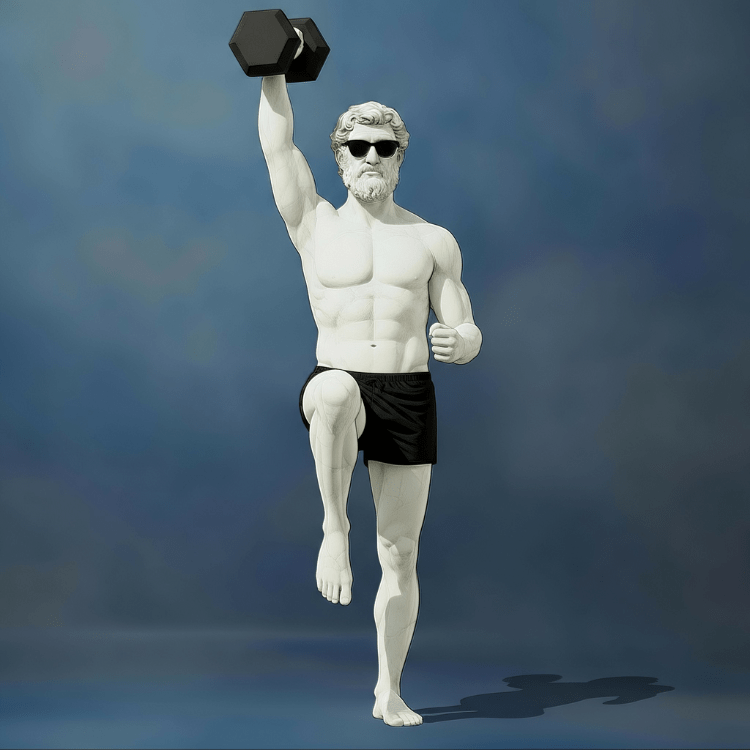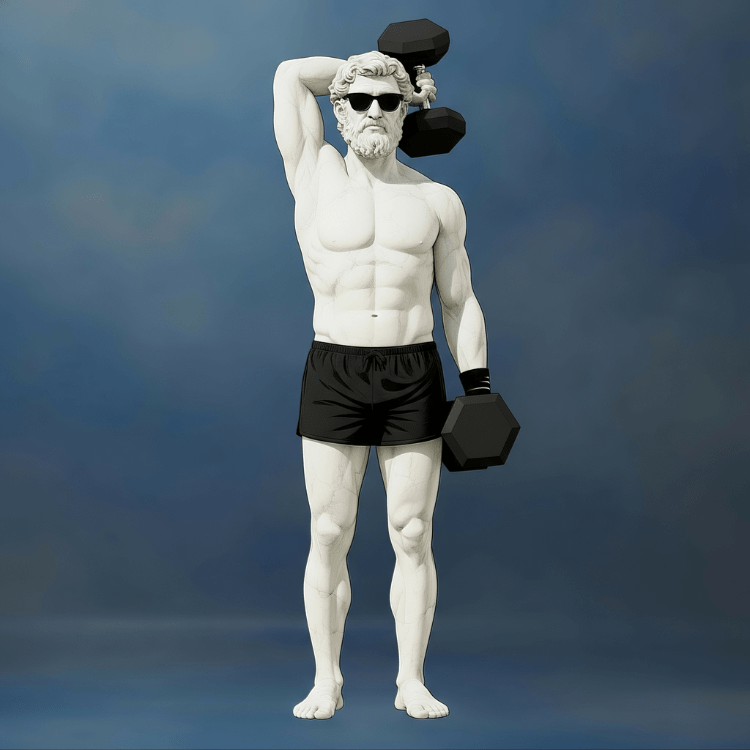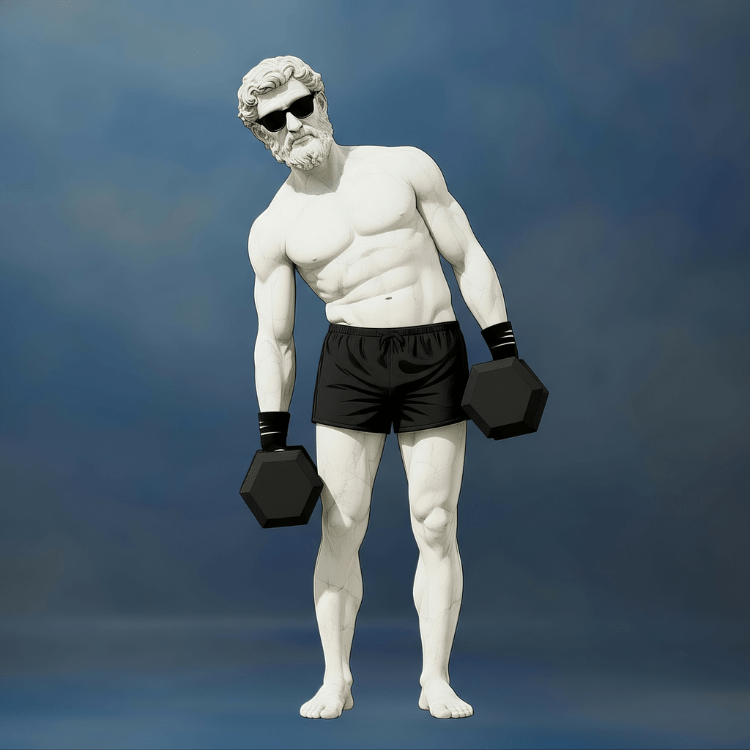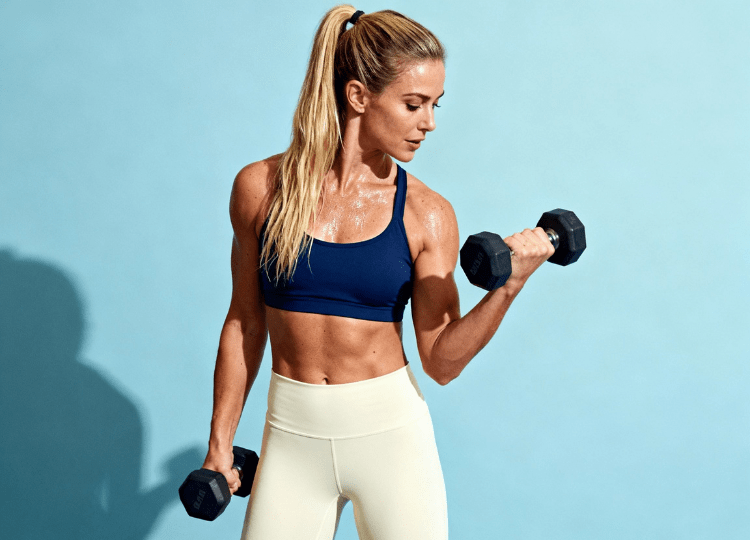If you’ve ever found yourself standing in your living room, holding a pair of dumbbells, thinking, “I want to feel like I did something… but I do not want to get on the floor,” this workout is for you.
Eight minutes. Fully standing. No mat. No planks. No crunches. No drama.
Just you, your dumbbells (or kettlebells, your choice), and a simple, effective circuit that hits your arms and abs in one tidy package.
This routine is perfect for busy days, travel days, “I only have a sliver of motivation” days, and basically any moment where you want strength without the production. And the best part? Every single move is deceptively effective. You’ll feel your arms light up, your core switch on, and your heart rate climb… not because the workout is chaotic, but because it’s smart.
Let’s get into it.
This blog is in partnership with our friends at Marble Guy – a YouTube channel for easy-to-follow workouts and exercise guides.
The 8-Minute Abs and Arm Workout
You’ll cycle through five exercises. Each lasts 30 seconds, but a couple are split between sides. You’ll run the circuit three times for a total of eight minutes.
There are no planned rest periods in the circuit itself. Before you panic, this is intentional. Each muscle group gets a little break while another takes over. Biceps rest while shoulders work, shoulders rest while triceps kick in, triceps rest while abs hold the line. It’s an active-recovery loop.
If you need 20–30 seconds between rounds, take it. But you may be surprised… many people can float through all three rounds without stopping, making this one of the most efficient micro-workouts in your toolkit.
Here’s the sequence:
1. Bicep Curls – 30 seconds

A classic for a reason. Curls don’t just build the front of your arms, they make everyday lifting and carrying easier. Groceries, bags, luggage, children who refuse to walk… all powered by biceps.
Trainer Tip: Keep your elbows glued to your sides. Move with control. Pretend the weights are expensive bottles of wine… you’re not swinging those around.
Common Mistake: Using momentum instead of muscle. If you feel your upper body rocking, pick a lighter weight.
2. Overhead Marches – 15 seconds left arm up, 15 seconds right arm up

This one looks simple, then you try it and suddenly your shoulder, core, and balance are all writing complaint letters.
By holding one dumbbell overhead while marching in place, you challenge shoulder endurance and teach your core to stabilize under load. It’s essentially an anti-tilt, anti-arch, anti-chaos drill.
Trainer Tip: Keep ribs down and abs braced so you don’t arch your back. Your raised arm should stay straight and directly overhead, not drifting forward or out to the side.
Common Mistake: Leaning toward the raised arm or letting the weight wander into strange angles.
3. Lateral Raises – 30 seconds

This is your shoulder-shaping, posture-boosting move. Lateral raises target your medial deltoids… the small but mighty muscles that help your shoulders stay strong, stable, and resilient.
Half a minute of these will humble anyone, even with light weights. That’s the point.
Trainer Tip: Lift only to shoulder height. Slight bend in your elbows. Smooth, controlled motion.
Common Mistake: Going too heavy and shrugging your shoulders up toward your ears. That’s not strength, it’s your traps panicking.
4. Tricep Extensions – 15 seconds left arm, 15 seconds right arm

If bicep curls are the fame, tricep extensions are the quiet engine that actually powers your pressing strength. Strong triceps support push-ups, overhead presses, and anything involving, well… pushing.
Single-arm variations challenge your stability a bit more, and they allow you to dial in form side-by-side.
Trainer Tip: Keep your elbow steady and pointed up. Your upper arm stays close to your head, like you’re trying to keep it in a narrow hallway.
Common Mistake: Flaring the elbow out or arching your lower back to get the weight up.
5. Side Bends – 15 seconds per side

A straightforward, standing oblique move that’s criminally underrated. These help your lateral stability… something you use in nearly every real-world movement, from walking to carrying bags on one side.
Side bends also help you feel connected to your obliques in a way that planks sometimes don’t.
Trainer Tip: Move slowly. Let gravity pull you down, then use your abs to pull yourself back upright.
Common Mistake: Twisting or rotating instead of bending cleanly to the side.
Why These Exercises Work So Well Together
This routine isn’t random. It’s structured to make the most of your time while building functional strength.
1. Balanced Arm Training
You hit biceps, shoulders, and triceps in a smart sequence:
- Bicep curls activate the front of your arms.
- Overhead marches take your shoulders and core for a spin.
- Lateral raises shape and strengthen the shoulders.
- Tricep extensions finish off the back of the arms.
It’s a full 360-degree approach without feeling like arm day at the gym.
2. Your Core Is Working the Whole Time
Even when you’re not doing a “core exercise,” your abs are engaged:
- Curls require stability to prevent rocking.
- Overhead marches are basically a standing core workout wearing a shoulder disguise.
- Lateral raises challenge anti-lean and anti-rotation muscles.
- Tricep extensions demand control to keep your spine aligned.
Then you go straight into side bends for direct oblique work.
3. No Floor, No Problem
For anyone who dislikes getting on the ground (tight hips, work clothes, pets that think planks mean “dog pile”), this is ideal.
Standing core work is often overlooked, but it’s incredibly functional… you live your life standing, not doing crunches on the floor.
4. Minimal Equipment, Maximum Efficiency
All you need is a pair of dumbbells.
If you only have kettlebells? Great.
If your weights are mismatched? Also fine.
If you’re traveling and have two filled water bottles? Still works.
The workout adapts to what you have.
How to Choose the Right Weight
Start with weights that feel light-ish. Yes, really.
This is an eight-minute continuous circuit with lots of controlled movement. Going too heavy too soon is the fastest way to turn this from a strength workout into a flailing-around workout.
Here’s a simple guide:
- For beginners: 2–5 kg / 5–10 lb dumbbells
- For intermediate: 5–8 kg / 10–18 lb dumbbells
- For advanced: 8–12 kg / 18–26 lb dumbbells
But honestly, let your form be the boss. The moment form breaks, you’re past your limit.
Once you own the movements, increase the weight a little… or increase the pace of your reps during each 30-second segment. That’s progressive overload in action.
Progression Ideas (When You Want a Little More)
If you enjoy this routine, and you will, you can level it up in a few easy ways:
1. Add a fourth round
Makes it a 10-minute session. Surprisingly spicy.
2. Use tougher tempos
- 2 seconds up, 2 seconds down
- Pause at the top of curls
- Slower marches with longer core engagement
Tempo is one of the simplest ways to increase difficulty without heavier weights.
3. Try heavier dumbbells once per week
If you normally use 5 kg, throw in one session with 6 or 7 kg. Your shoulders will have… thoughts.
4. Pair it with a steps goal
Do this routine before heading out for a walk. It warms your shoulders and wakes up your core, making everyday movement feel smoother.
5. Turn it into a “bookend workout”
- 8 minutes before your main workout as a warmup
- Or 8 minutes after for a finisher
Arms + abs pair beautifully with almost any training style.
Why You’ll Love This Workout
Beyond the convenience… because yes, it’s extremely convenient… there are a few reasons this little routine pulls more weight than you’d expect.
1. It Supports Longevity
You’re training:
- Strength
- Stability
- Coordination
- Shoulder endurance
- Core control
All things you want working well not just today, but decades from now. Standing core work and shoulder stability are huge for aging gracefully and powerfully.
2. It Improves Everyday Movement
Think about life:
Carrying groceries. Loading luggage into overhead bins. Reaching high shelves. Rotating to grab a seatbelt. Marching up stairs with a bag on one side.
This workout hits all of that.
3. It Works in Small Spaces
Hotel rooms. Offices. Bedrooms. Corners of chaotic homes. You only need enough space to… stand.
4. It’s Fast
Eight minutes is friendly. Even on low-energy days, eight minutes feels doable. That makes consistency easier, and consistency is where the real results live.
5. It Builds Definition (Without the Grind)
You’re getting volume on the arms, time under tension on the shoulders, and consistent core activation. Do this a couple times a week and the definition shows up.
A Few Coaching Notes Before You Start
Because small tips make big differences:
Breathe on purpose
Exhale on the effort. Inhale on the return. It stabilizes your spine and stops you from collecting tension in the wrong places.
Move slower than you think
Fast reps are rarely better reps. Controlled movement gives you better muscle recruitment, safer joints, and more actual results.
Keep your abs gently braced throughout
Not a full crunch, just think “tight around the waist.” This protects your lower back and instantly improves your form on every exercise.
Shake it out between rounds
A few seconds of arm circles or light loosening resets your shoulders beautifully before starting again.
Bottom Line
If you’re looking for a simple but powerful way to strengthen your arms and core—without getting on the floor or committing to a long workout—this 8-minute standing routine is a game changer.
It’s quick, it’s smart, and it fits into almost any schedule. The exercises are approachable but effective, the format is easy to follow, and the results add up fast.
Whether you use it as your main workout on busy days or as a top-up to your regular training, this little circuit delivers exactly what it promises: stronger arms, a more stable core, and that satisfying “I really did something” feeling—all in less time than it takes to make a coffee.
Related Articles:
Quick 5 Minute Ab Workout At Home For A Stronger Core
